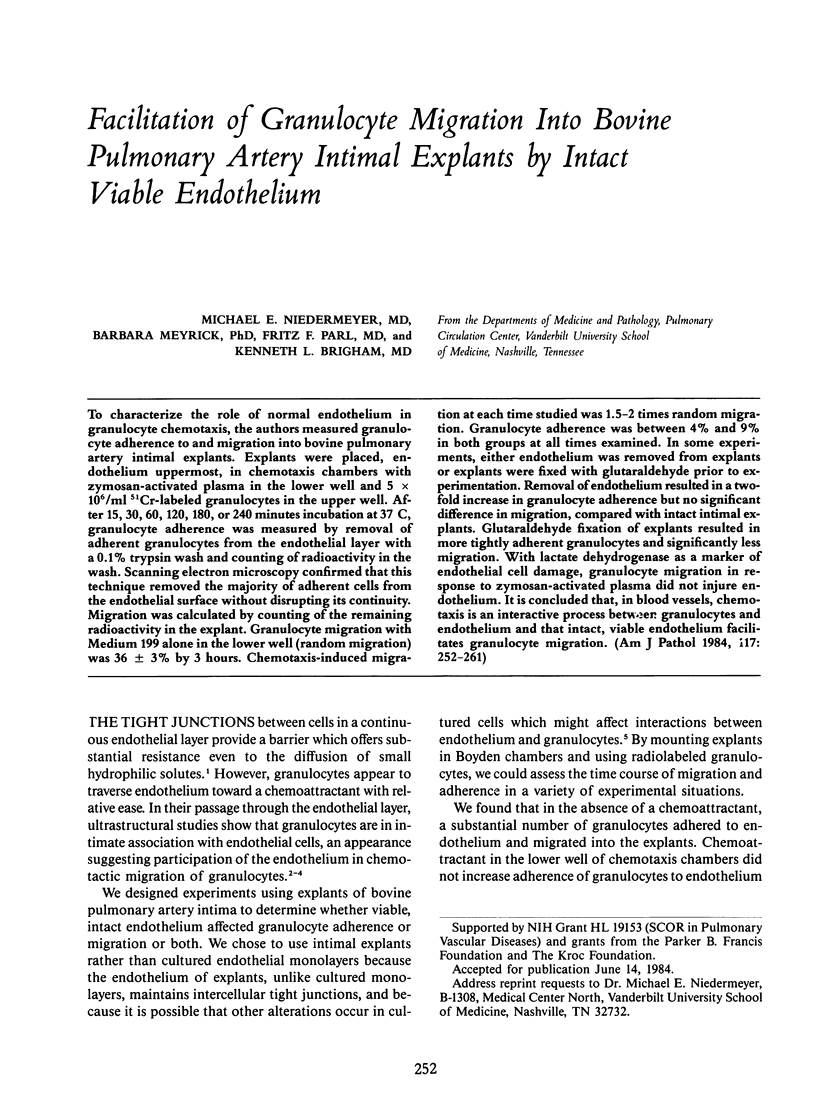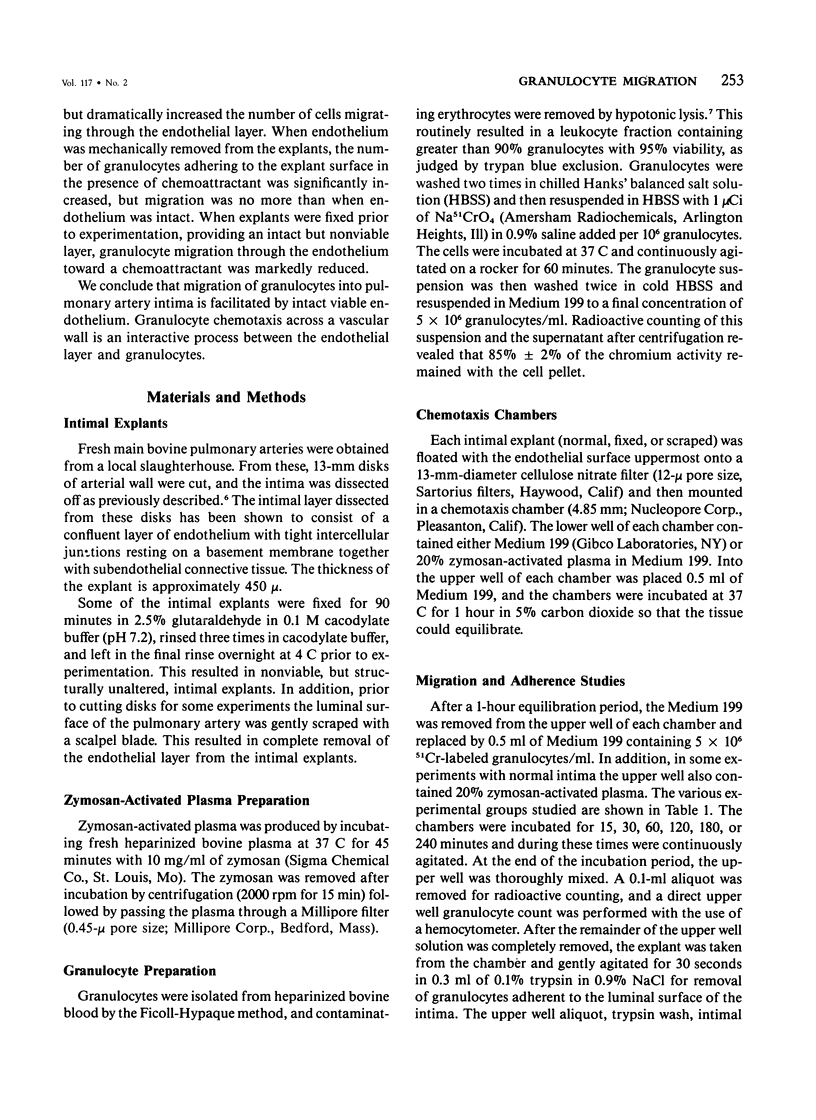Abstract
To characterize the role of normal endothelium in granulocyte chemotaxis, the authors measured granulocyte adherence to and migration into bovine pulmonary artery intimal explants. Explants were placed, endothelium uppermost, in chemotaxis chambers with zymosan-activated plasma in the lower well and 5 X 10(6)/ml 51Cr-labeled granulocytes in the upper well. After 15, 30, 60, 120, 180, or 240 minutes incubation at 37 C, granulocyte adherence was measured by removal of adherent granulocytes from the endothelial layer with a 0.1% trypsin wash and counting of radioactivity in the wash. Scanning electron microscopy confirmed that this technique removed the majority of adherent cells from the endothelial surface without disrupting its continuity. Migration was calculated by counting of the remaining radioactivity in the explant. Granulocyte migration with Medium 199 alone in the lower well (random migration) was 36 +/- 3% by 3 hours. Chemotaxis-induced migration at each time studied was 1.5-2 times random migration. Granulocyte adherence was between 4% and 9% in both groups at all times examined. In some experiments, either endothelium was removed from explants or explants were fixed with glutaraldehyde prior to experimentation. Removal of endothelium resulted in a two-fold increase in granulocyte adherence but no significant difference in migration, compared with intact intimal explants. Glutaraldehyde fixation of explants resulted in more tightly adherent granulocytes and significantly less migration. With lactate dehydrogenase as a marker of endothelial cell damage, granulocyte migration in response to zymosan-activated plasma did not injure endothelium. It is concluded that, in blood vessels, chemotaxis is an interactive process between granulocytes and endothelium and that intact, viable endothelium facilitates granulocyte migration.
Full text
PDF









Images in this article
Selected References
These references are in PubMed. This may not be the complete list of references from this article.
- Beesley J. E., Pearson J. D., Hutchings A., Carleton J. S., Gordon J. L. Granulocyte migration through endothelium in culture. J Cell Sci. 1979 Aug;38:237–248. doi: 10.1242/jcs.38.1.237. [DOI] [PubMed] [Google Scholar]
- Buchanan M. R., Vazquez M. J., Gimbrone M. A., Jr Arachidonic acid metabolism and the adhesion of human polymorphonuclear leukocytes to cultured vascular endothelial cells. Blood. 1983 Oct;62(4):889–895. [PubMed] [Google Scholar]
- Craddock P. R., Hammerschmidt D. E., Moldow C. F., Yamada O., Jacob H. S. Granulocyte aggregation as a manifestation of membrane interactions with complement: possible role in leukocyte margination, microvascular occlusion, and endothelial damage. Semin Hematol. 1979 Apr;16(2):140–147. [PubMed] [Google Scholar]
- Fehr J., Dahinden C. Modulating influence of chemotactic factor-induced cell adhesiveness on granulocyte function. J Clin Invest. 1979 Jul;64(1):8–16. doi: 10.1172/JCI109466. [DOI] [PMC free article] [PubMed] [Google Scholar]
- Gallin J. I., Clark R. A., Kimball H. R. Granulocyte chemotaxis: an improved in vitro assay employing 51 Cr-labeled granulocytes. J Immunol. 1973 Jan;110(1):233–240. [PubMed] [Google Scholar]
- Gimbrone M. A., Jr, Buchanan M. R. Interactions of platelets and leukocytes with vascular endothelium: in vitro studies. Ann N Y Acad Sci. 1982;401:171–183. doi: 10.1111/j.1749-6632.1982.tb25716.x. [DOI] [PubMed] [Google Scholar]
- Goldsmith J. C. Contribution of the subendothelium to prostacyclin release after vascular injury. J Lab Clin Med. 1982 Oct;100(4):574–584. [PubMed] [Google Scholar]
- Hoover R. L., Briggs R. T., Karnovsky M. J. The adhesive interaction between polymorphonuclear leukocytes and endothelial cells in vitro. Cell. 1978 Jun;14(2):423–428. doi: 10.1016/0092-8674(78)90127-7. [DOI] [PubMed] [Google Scholar]
- Hoover R. L., Folger R., Haering W. A., Ware B. R., Karnovsky M. J. Adhesion of leukocytes to endothelium: roles of divalent cations, surface charge, chemotactic agents and substrate. J Cell Sci. 1980 Oct;45:73–86. doi: 10.1242/jcs.45.1.73. [DOI] [PubMed] [Google Scholar]
- Lackie J. M., de Bono D. Interactions of neutrophil granulocytes (PMNs) and endothelium in vitro. Microvasc Res. 1977 Jan;13(1):107–112. doi: 10.1016/0026-2862(77)90119-4. [DOI] [PubMed] [Google Scholar]
- MARCHESI V. T., FLOREY H. W. Electron micrographic observations on the emigration of leucocytes. Q J Exp Physiol Cogn Med Sci. 1960 Oct;45:343–348. doi: 10.1113/expphysiol.1960.sp001489. [DOI] [PubMed] [Google Scholar]
- MARCHESI V. T. The site of leucocyte emigration during inflammation. Q J Exp Physiol Cogn Med Sci. 1961 Apr;46:115–118. doi: 10.1113/expphysiol.1961.sp001522. [DOI] [PubMed] [Google Scholar]
- MacGregor R. R., Macarak E. J., Kefalides N. A. Comparative adherence of granulocytes to endothelial monolayers and nylon fiber. J Clin Invest. 1978 Mar;61(3):697–702. doi: 10.1172/JCI108981. [DOI] [PMC free article] [PubMed] [Google Scholar]
- Malick L. E., Wilson R. B. Modified thiocarbohydrazide procedure for scanning electron microscopy: routine use for normal, pathological, or experimental tissues. Stain Technol. 1975 Jul;50(4):265–269. doi: 10.3109/10520297509117069. [DOI] [PubMed] [Google Scholar]
- Meyrick B., Brigham K. L. Increased permeability associated with dilatation of endothelial cell junctions caused by histamine in intimal explants from bovine pulmonary artery. Exp Lung Res. 1984;6(1):11–25. doi: 10.3109/01902148409087892. [DOI] [PubMed] [Google Scholar]
- Meyrick B., Hoffman L. H., Brigham K. L. Chemotaxis of granulocytes across bovine pulmonary artery intimal explants without endothelial cell injury. Tissue Cell. 1984;16(1):1–16. doi: 10.1016/0040-8166(84)90014-4. [DOI] [PubMed] [Google Scholar]
- Pearson J. D., Carleton J. S., Beesley J. E., Hutchings A., Gordon J. L. Granulocyte adhesion to endothelium in culture. J Cell Sci. 1979 Aug;38:225–235. doi: 10.1242/jcs.38.1.225. [DOI] [PubMed] [Google Scholar]
- Russo R. G., Liotta L. A., Thorgeirsson U., Brundage R., Schiffmann E. Polymorphonuclear leukocyte migration through human amnion membrane. J Cell Biol. 1981 Nov;91(2 Pt 1):459–467. doi: 10.1083/jcb.91.2.459. [DOI] [PMC free article] [PubMed] [Google Scholar]
- Ryan U. S., Mortara M., Whitaker C. Methods for microcarrier culture of bovine pulmonary artery endothelial cells avoiding the use of enzymes. Tissue Cell. 1980;12(4):619–635. doi: 10.1016/0040-8166(80)90017-8. [DOI] [PubMed] [Google Scholar]
- Taylor R. F., Price T. H., Schwartz S. M., Dale D. C. Neutrophil-endothelial cell interactions on endothelial monolayers grown on micropore filters. J Clin Invest. 1981 Feb;67(2):584–587. doi: 10.1172/JCI110071. [DOI] [PMC free article] [PubMed] [Google Scholar]
- Weening R. S., Roos D., Loos J. A. Oxygen consumption of phagocytizing cells in human leukocyte and granulocyte preparations: a comparative study. J Lab Clin Med. 1974 Apr;83(4):570–577. [PubMed] [Google Scholar]



